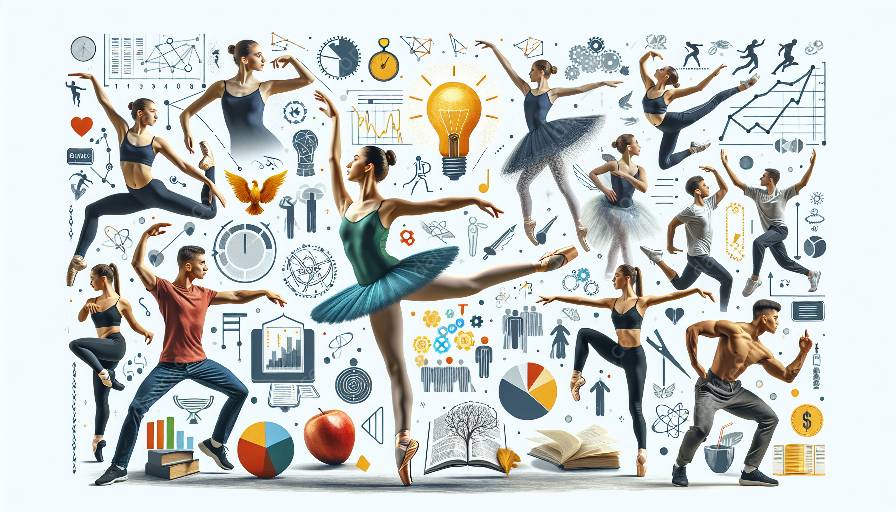Dance is a physically demanding art form that requires a high level of fitness, strength, flexibility, and endurance. To meet the rigorous demands of dance, many dancers incorporate cross-training into their training loads. Cross-training involves engaging in different forms of exercise and physical activity to complement and enhance a dancer's primary training regimen.
Benefits of Cross-Training for Dancers:
1. Injury Prevention: By engaging in a variety of exercises, dancers can reduce the risk of overuse injuries and muscle imbalances. Cross-training allows them to strengthen different muscle groups, improve overall stability, and prevent repetitive strain injuries.
2. Enhancing Fitness Levels: Participating in activities such as swimming, Pilates, yoga, or strength training can improve dancers' cardiovascular endurance, muscular strength, and flexibility, leading to enhanced performance and stamina.
3. Mental Refreshment: Engaging in diverse physical activities can provide mental relief from the repetitive nature of dance training. Cross-training can reduce burnout, enhance motivation, and prevent mental fatigue.
Effective Cross-Training Strategies:
Dancers can incorporate cross-training into their routines in several ways. It's essential to select activities that complement and support their dance goals while minimizing the risk of overtraining. Cross-training activities should aim to enhance rather than detract from a dancer's primary training.
1. Aerobic Conditioning: Activities such as cycling, swimming, or elliptical training can improve dancers' cardiovascular fitness without causing excessive impact on their joints, providing an effective way to increase overall endurance.
2. Strength and Conditioning: Dancers can benefit from strength training exercises that target specific muscle groups, focusing on core strength, lower body stability, and upper body strength to improve overall performance and prevent injuries.
3. Flexibility and Mobility: Incorporating activities like yoga, Pilates, or stretching routines can help dancers maintain and enhance their flexibility, reduce muscle tightness, and improve joint mobility, contributing to better movement quality.
It's important for dancers to integrate cross-training in a balanced and strategic manner, ensuring that it complements their dance training without causing excessive fatigue or detracting from their primary goals. When managed effectively, cross-training can contribute to a dancer's overall physical and mental well-being, enhancing their longevity in the art form.
Training Load Management for Dancers
Effective training load management is essential for dancers to maintain optimal performance and prevent overtraining injuries. Dancers often face unique challenges related to their training loads, such as intense rehearsal schedules, performances, and pressure to meet artistic and technical demands. Managing these loads requires a comprehensive approach that considers both physical and mental health.
Key Considerations for Training Load Management:
1. Periodization: Dancers can benefit from structured periodization plans that include varying training intensities and volumes throughout the year. This approach allows for adequate recovery and adaptation, reducing the risk of overuse injuries and burnout.
2. Monitoring Workload: Utilizing tools such as heart rate monitors, activity trackers, and subjective load assessments can help dancers and their trainers monitor training intensities and volumes, enabling adjustments to prevent excessive strain and fatigue.
3. Recovery Strategies: Incorporating strategic recovery practices, including adequate rest, nutrition, hydration, and sleep, is vital for dancers to replenish their energy stores and repair tissues stressed during training and performance.
Physical and Mental Health in Dance
Physical and mental health is paramount for dancers to perform at their best and sustain long, successful careers. Addressing the holistic well-being of dancers involves fostering a supportive training environment that prioritizes both physical and psychological health.
Strategies for Promoting Physical and Mental Health:
1. Injury Prevention and Rehabilitation: Implementing injury prevention programs and providing access to rehabilitation services can minimize the impact of injuries on dancers' physical and mental well-being, supporting their ability to perform and recover effectively.
2. Mental Wellness Support: Offering access to mental health resources, including counseling and stress management techniques, can help dancers navigate the pressures and challenges of the dance profession, promoting resilience and psychological well-being.
3. Holistic Training Approach: Embracing an integrative approach to training that prioritizes balanced nutrition, appropriate rest, and diverse cross-training activities can nurture the overall health of dancers, supporting their physical and mental resilience.
By integrating cross-training, effective training load management, and a holistic approach to physical and mental health, dancers can optimize their performance, reduce the risk of injuries, and cultivate long and fulfilling careers in the world of dance.


































